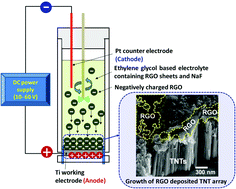Combined electrophoretic deposition–anodization method to fabricate reduced graphene oxide–TiO2nanotube films†
Abstract
We directly constructed reduced graphene oxide–

* Corresponding authors
a
ARC Centre of Excellence for Functional Nanomaterials, School of Chemical Engineering, the University of New South Wales, Sydney, NSW, Australia
E-mail:
r.amal@unsw.edu.au, yh.ng@unsw.edu.au
Fax: +612-9385-5966
Tel: +612-9385-4361
b Centre for Computational Molecular Science, Australia Institute for Bioengineering and Nanotechnology (AIBN), the University of Queensland, Brisbane, QLD, Australia
We directly constructed reduced graphene oxide–

 Please wait while we load your content...
Something went wrong. Try again?
Please wait while we load your content...
Something went wrong. Try again?
J. Yun, R. J. Wong, Y. H. Ng, A. Du and R. Amal, RSC Adv., 2012, 2, 8164 DOI: 10.1039/C2RA20827J
To request permission to reproduce material from this article, please go to the Copyright Clearance Center request page.
If you are an author contributing to an RSC publication, you do not need to request permission provided correct acknowledgement is given.
If you are the author of this article, you do not need to request permission to reproduce figures and diagrams provided correct acknowledgement is given. If you want to reproduce the whole article in a third-party publication (excluding your thesis/dissertation for which permission is not required) please go to the Copyright Clearance Center request page.
Read more about how to correctly acknowledge RSC content.
 Fetching data from CrossRef.
Fetching data from CrossRef.
This may take some time to load.
Loading related content
